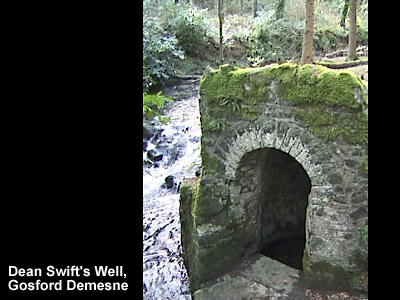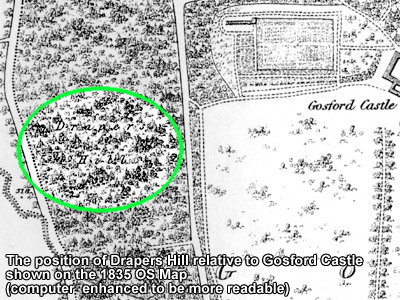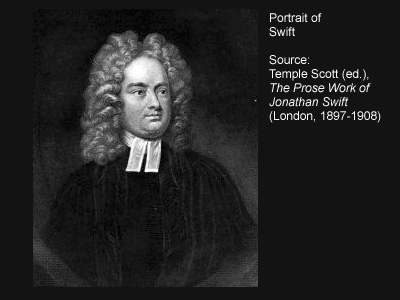
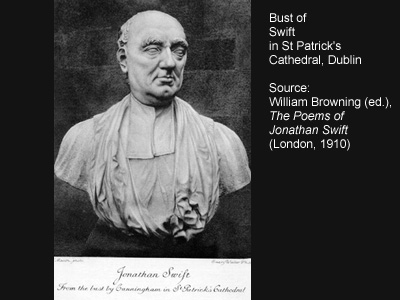
Jonathan Swift (1667-1745) is one of Ireland's greatest writers. He combined a career as a clergyman with an interest in writing and politics. Nowadays, we remember him best for having written the novel Gulliver's Travels and for his political, satirical essay A Modest Proposal. He was renowned for his entertaining and witty conversation as well as for his writing. As a result, he was a popular guest in high-society circles. Despite his powerful connections, he retained a sympathy for the condition of the poor in Ireland. He was a holiday guest of the Acheson family at Gosford Desmesne three times between 1728 and 1730 and wrote a number of poems based on his experiences in the area.
INTRODUCTION
Jonathan Swift will possibly be best remembered for his authorship of the novel Gulliver's Travels. But to see only his writing is to ignore a part of the riddle that made up the man. A confident satirical style, insatiable ego, political 'spin-doctoring' and his bold claim to have no need of any woman are all traits we associate with the writer. But behind this public persona was a man plagued by insecurity and ill health. A man both revered and reviled, his legend has continued to confuse and delight down through the ages.
CHILDHOOD DAYS
Swift was born in Dublin on November 30th, 1667. A year after his birth he was 'amicably kidnapped' by his nurse and taken to Cumbria. On discovery of his absence Swift's mother wrote to the nurse and asked her to take care of the boy until he was fit for a return journey. He was returned to Ireland aged three and, he later claimed, could read any chapter from the Bible, a difficult act for one so young.
Shortly after his return, Swift's mother went to live in Leicester, leaving Jonathan and his sister Jane in the care of their uncles, their father having died seven months before Jonathan's birth. In 1673 he was sent as a boarder to Kilkenny College. Looking back, Swift said he had been wrong only to remember the pleasant things and forget,
"The confinement ten hours a day to nouns and verbs, the terror of the rod, the bloody noses and broken shins".
In 1682 Swift, aged fourteen, entered Trinity College, Dublin. From the beginning he was embarrassed of his poverty and seemed to show no enthusiasm for his studies. He later wrote,
"He neglected his academic studies, for some parts of which he had no great relish by nature, and turned himself to reading history and poetry...he was stopped of his degree for dullness and insufficiency". [In his writings, Swift was in the habit of referring to himself in the third person.]
Swift's most recorded offence was non-attendance at prayers which were held at 6am, 10am and 4pm. His Bachelor of Arts degree was completed in 1686 but he barely scraped through. Although he continued to study for a Master of Arts degree, he was brought before the Junior Dean for frequenting the town and causing fights. Being forced to ask pardon from Owen Lloyd was a humiliation for Swift but he exacted revenge twenty years later in a scathing literary portrait of Lloyd and his wife.
APPRENTICESHIP
His studies at Trinity were interrupted by war as the deposed Catholic King James attempted to regain the throne from the Protestant King William. Like many Protestants, Swift feared a Jacobite victory and abandoned his studies. In 1689 he moved to his mother's house in Leicester and took up a secretarial position with ex-diplomat and writer, Sir William Temple. It was there, at Moor Park, Surrey, that Swift began to exercise his ambition to write. There, also, he suffered the first bouts of giddiness and coldness of the stomach that would plague him all his life. This condition has been retrospectively diagnosed as Ménières Syndrome. Symptoms were brought about by a lesion in the labyrinth of the ear, and included deafness, giddiness, oscillation of the eyeball and sometimes loss of consciousness.
Following the victory of King William at the Battle of the Boyne in 1690 Swift returned to Ireland. He occupied his time by pursuing his desire to write, as he communicated to a parson friend,
"There is something in me which must be employed, and when I am alone, turns all, for want of practice, into speculation and thought".
POLITICS AND THE CHURCH
To finance his endeavours Swift continued acting as secretary to Sir William Temple, making three visits to Moor Park. However, before he made his last visit Swift acquired a more permanent profession when he took Holy Orders. Contemporaries and more recent biographers have continually called Swift's devotion to the church into question. We cannot speculate as to the state of his heart but Swift was a talented man and there is no reason for believing he was anything but an asset to the church. In 1700 he was appointed Vicar of Laracor in Co.Meath. Two years later he paid for the title of Doctor of Divinity, a not uncommon practice in those days.
Between 1704 and 1709 Swift spent much time in England on an official mission from the church in Ireland to the court of Queen Anne. Although he never actually met the Queen he was able to make valuable contacts within the court that, he hoped, would help his career. Swift gained further notoriety when his 'Tale of a Tub' was published in 1704. Although the work was published anonymously Swift's authorship was very quickly established, perhaps because he was also the author of several political pamphlets at this time.
His interest in politics brought him into the realm of Tory politics and between 1710 and 1714 he was an active propagandist for the Tory party, not unlike spin-doctors of the modern era. In fact his political evangelism was instrumental in causing the downfall of the Duke of Marlborough and in influencing public opinion against the war with France. Swift hoped to use his influential court friends to acquire an influential and wealthy English Bishopric but with the death of Queen Anne, and the subsequent disintegration of the Tories, his plans were dashed. The best position his friends could obtain for him was Dean of St.Patrick's Cathedral in Dublin.
THE GOSFORD CONNECTION
Although the position was unlikely to have satisfied an ambition as keen as Swift's, it was nevertheless a prestigious appointment. If nothing else he used it to inflate his own ego, surrounding himself with associates he could dominate and cultivating friendships with various titled families and landed gentry.
One such was the Acheson family of Gosford Demesne, Co.Armagh. The acquaintance was likely to have been through Philip Savage. The former Chancellor of the Exchequer was a long-term friend of Swift and also father to Lady Anne Acheson. Swift made three visits to the Acheson's estate, the first of which was probably in 1728. (England adopted a new calendar in 1752. This makes precise dating difficult as some writers continued to use the old calendar while others adopted the revised version.)
This first visit was intended to be a short summer holiday, with the planned return set for Christmas of that year. But by the end of the summer Swift wrote to his housekeeper to request a new periwig, gown and cassock. He seemed to enjoy the company and wrote to a friend,
"Sir Arthur is a man of sense, and a scholar, has a good voice, and my Lady is better; she is perfectly well bred, and desirous to improve her understanding, which is very good, but cultivated too much like a fine Lady".
We may question whether or not the Acheson's enjoyed his visit to the same extent. On each visit he brought with him at the least two horses and two dogs, and inflicted upon the household such behaviour as to render his visit something of a tyranny. In his poem 'A Panegyrick On The Dean', Swift, in the guise of Lady Anne Acheson, makes reference to his varied exploits as, "Dean, Butler, Usher, Jester, Tutor..." In other poems he mentions the orders he gave for the cutting down of the old thorn bush, and the ill feeling this caused. Still further it seems the eager Dean engaged in the construction of toilet building to provide separate facilities for Ladies and Gents!
Despite this Swift stayed with the Acheson's on two more occasions and in fact purchased a plot of land on the estate with the intention of building a house. However, there was a significant cooling of the relationship and the building plans never came to fruition, a situation explained in his poem 'The Dean's Reasons for not Building at Drapier's Hill'. The poem suggests the Acheson's had wearied of being the subject of his wit and had made their offence perfectly plain, a fact Swift seemed to resent,
"For, why should I continue still
To serve a friend against his will?"
He continued to visit with Lady Acheson after she had left her husband and gone to live with her mother in Baldoyle, but his connection with the Gosford Estate was forever severed following his third stay in 1730.
There has been some suggestion that Swift based his most famous novel, 'Gulliver's Travels', on his experience of Gosford estate and the village of Markethill. Much as we would like to claim this fragment of literary history it nevertheless seems unlikely. If we are correct in the dating of his first visit, as 1728, the novel was written two years before his first visit. Despite this Swift did write about his experiences at the estate and it was during his time at the estate that he wrote much of the volume 'On Poetry - A Rhapsody'.
The following is a selection of the poems Swift wrote about his experiences of the Acheson's and Gosford:
THE MAN WHO MOVED THE PEN
The enigma of Jonathan Swift has persisted throughout the ages. According to Lord Orrey Swift had,
"A natural severity of face, which even his smiles could scarce soften, or his utmost gaiety render placid and serene".
Yet he was possessed of a lively sense of humour, albeit at the expense of those around him. On one occasion Swift was occupied by composing a sermon for the Sunday service at St.Patrick's, but his efforts were frustrated by the noise from a large crowd gathered outside the Cathedral. He was informed they had congregated there as it was the best vantage point from which to watch a solar eclipse. A discontented Swift dispatched his servant to announce that he had cancelled the solar eclipse. Believing him powerful enough to perform such an act the crowd dispersed, leaving Swift to finish his sermon in peace.
His theory about the art of conversation also sheds some light on the eccentricity of the man. His philosophy was that each person at the table had the right to speak for one minute. If after a few moments pause no one took on the conversation the first speaker had the right to continue. No doubt the threat of being cruelly satirised allowed Swift to dominate the conversation.
The satirical nature of Swift's poetry suggests a confidence entirely lacking in his private life. The lover of two women he nevertheless refused to commit to either, or indeed acknowledge either one as his wife. Both women followed him to Ireland and it seems knew about his relationship with the other. In his correspondence with Hester Vanhomrigh and Esther Johnson, who he called Vanessa and Stella, his handwriting displays uncharacteristic uncertainty. Indeed he was given to writing in a long string of indecipherable capital letters. (eg. MD MD MD FW FW FE ME ME ME LELE LELE LELE). It is likely Swift never intended this correspondence to become part of public consumption but, during a bout of illness he gave an unruly bundle of papers to his nephew Deane Swift, who later became a biographer of his literary uncle. (On this occasion Deane is a christian name, not an ecclesiastical title). Both of these women died in the 1720's leaving Swift alone and lonely. The desire for a change of company and scenery is perhaps what brought him to the Acheson estate at Gosford.
THE LAST CHAPTER
Throughout his life Swift's literary ambitions were never matched by his physical stamina. Indeed by the 1730's his health had deteriorated rapidly causing him to write to a friend,
For much of the rest of his life he was a recluse as his condition steadily declined. Before his death he willed all his money to the building of St.Patrick's hospital for "idiots and lunatics", a building which still stands today.
As befitted a Dean of the Cathedral, Swift was buried on the south side of the Great aisle, beside a monument of Primate Narcissus Marsh. The black marble slab that marks his resting place reads,
"Hic Depositum Est Corpus
Jonathan Swift, S.T.D.
Hujus Ecclesiae Cathedralis
Decani
Ubi Saeva Indignatio
Ulterius
Cor Lacerare Nequit
Abi, Viator
Et Imitare, si poteris
Strenuum pro virili
Libertatis Vindicatorem".
Translated this means,
"Here lies Jonathan Swift, Doctor of Divinity, Dean of this Cathedral Church, where savage indignation can no longer lacerate his heart. Go Traveller, and imitate if you can one who with all his might championed liberty".


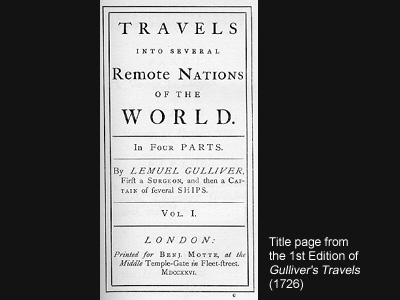
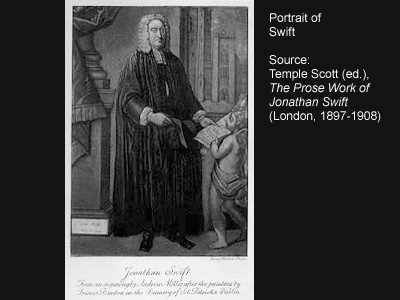
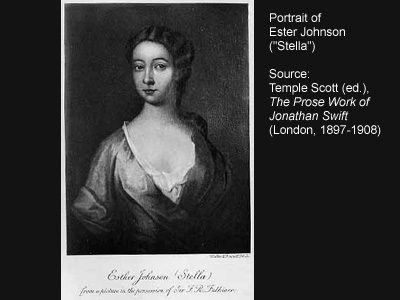
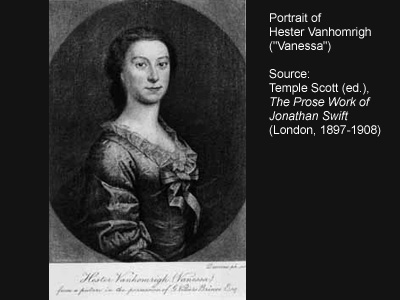
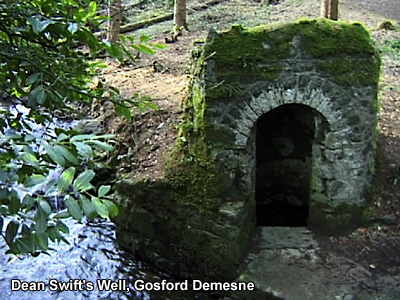 >
>
